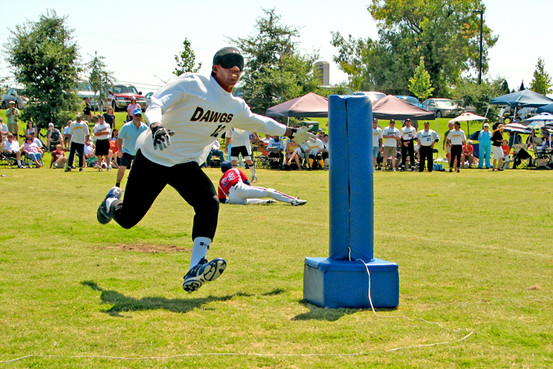How People Who are Blind Play Baseball
Baseball, like many other sports, requires good hand-eye coordination. This is especially true if you’re trying to hit a pitched ball with a bat — a 75 mile per hour fastball (fast for amateurs, but comically slow if you’re a Major League pitcher) reaches home plate in less than a second. Our eyes have even less time than that to decide whether to swing and, if so, where and how quickly. Many people, for that reason alone, have a hard time hitting a pitched ball — we can’t process the information we see quickly enough. Trying to hit a pitch with your eyes closed or if you’re blind? Forget it.
Unless it beeps.
In 1964, a man named Charley Fairbanks, an engineer for a telephone company, came up with a way to allow blind fans of baseball to play the game as well. Fairbanks took a softball-sized ball and embedded a noisemaker in it — something which made a beeping noise. Now, instead of watching the ball leave the pitcher’s hand as it flies toward home plate, players could hear it coming, getting progressively louder as it approached. Fairbanks also redesigned the bases so that they, too, emitted a sound — a whistling noise — so the batter knew where to run. Combined, these changes made the game accessible to those with impaired vision. But for various reasons (for example, the bats damaged the ball’s beeper), the modifications proved unpopular.
The efforts did not end there, however. In 1975, another entrepreneur took another crack at Fairbanks’ idea, focused on a larger, more resilient ball. That ball worked so well that the Braille Sports Foundation in Minnesota organized a few games in Minneapolis and, later, St. Paul. Over the next few months, these teams developed the rules to a baseball-based sport called “Beep Baseball.” The rules are similar to what baseball fans are familiar with, but with a few major changes.
First, the pitcher and catcher — both of which are sighted — are on the batter’s team. The pitcher tells the batter when to swing while the catcher helps the batter figure out where. Second, there are only six fielders; their jobs are to control a batted ball (by listening for and following the beeping sound) before the batter safely reaches a base. And finally, there are only two bases (roughly where first and third would be) and they have large, padded columns as seen below. Once the batter puts the ball in play, a (sighted) umpire hits a button, and one of the two bases begins to buzz. If the batter touches the buzzing base before the fielders gain control of the ball, he scores a run; otherwise, he’s out. (There is no baserunning.) Each team gets the standard three outs per inning, but there are only six innings in every game.

Beep baseball isn’t just a casual activity, either. In 1976, teams formed a league — the National Beep Baseball Association. The Association has been organizing games and tournaments between Beep Baseball teams for over forty years, with dozens of active teams playing today. And, since 1995, the NBBA has been running a championship tournament — the Beep Baseball World Series — each summer. Just like in the Majors, Beep Baseball can have its dramatic endings, too. In 2011, for example, the West Coast Dawgs (from Fresno, California) won the championship game 11 to 10 — and scored their last five runs with only one out to go. Want to see the drama for yourself? ESPN covered the story, including that final inning — you can watch it here.
 Bonus Fact: The world will probably never have a blind professional baseball player, but there have been a few deaf ones (although most came before World War I). Most recently, deaf outfielder Curtis Pride made his Major League debut with the Montreal Expos in September of 1993. He couldn’t hear the roar of the crowd, but that didn’t prevent him from having a solid, 11-year career as a backup outfielder over which he hit 20 home runs. (For those who know anything about advanced baseball metrics, Pride put up a 1.8 bWAR in 301 PA for the Detroit Tigers in 1996.)
Bonus Fact: The world will probably never have a blind professional baseball player, but there have been a few deaf ones (although most came before World War I). Most recently, deaf outfielder Curtis Pride made his Major League debut with the Montreal Expos in September of 1993. He couldn’t hear the roar of the crowd, but that didn’t prevent him from having a solid, 11-year career as a backup outfielder over which he hit 20 home runs. (For those who know anything about advanced baseball metrics, Pride put up a 1.8 bWAR in 301 PA for the Detroit Tigers in 1996.)
From the Archives: Bat Man: A blind man who can use echolocation to ride a bicycle.
Take the Quiz: Identify these 12 blind people from mythology.
Related: “Seeing Home” by Ed Lucas, the autobiography of the first blind person to become a successful baseball broadcaster. 4.9 stars on 13 reviews.
